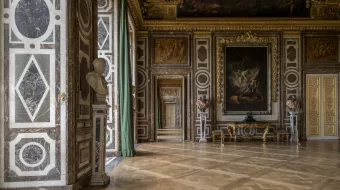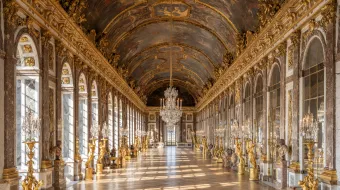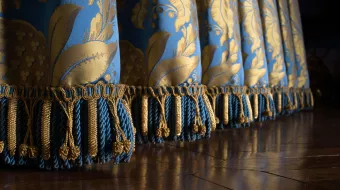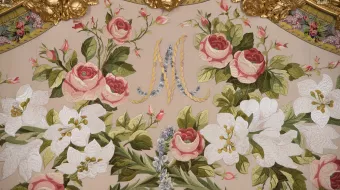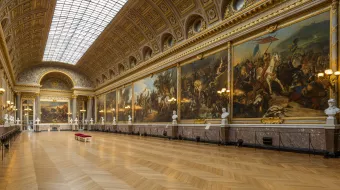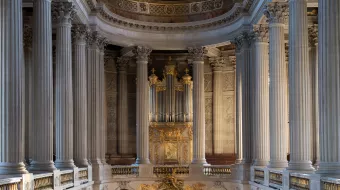To discover the most famous parts of the Palace, or to see them from a new angle. This route can be adapted to suit your group and the theme you wish to address: the symbols of monarchy, mythological themes, architecture, the history of Europe depicted in the paintings of the Hall of Mirrors and the Gallery of Great Battles...
Groupes One Palace, a multi-facetted history
PRACTICAL INFORMATION
Duration of visit
Plan for 1.5 hours, preferably in the morning when the Palace opens at 9 am or in the afternoon after 3 pm
Check the detailed timetable
Avoid the crowds
Recommended season
All seasons
Place
Palace
Ticket
Free admission by booking a self-guided tour (speaking rights) or unaccompanied visit (no reservation, no speaking rights).
The Main Courtyard
After the first security check at the Main Gate, you will be able to admire the Royal Gate leading into the royal courtyard, and beyond that, in the centre, the heart of the first building built by Louis XIII. The “Old Palace” (to distinguish it from Louis XIV’s “New Palace”) is characterised by the contrasting colours of the materials: red brick, white stone and grey slates, highlighted by gold decoration. Louis XIV decided to enlarge his father’s hunting lodge and moved there on a permanent basis in 1682.
Look at the facades and try to guess where the King’s chamber lies…
It is on the first floor, at the centre of the central pavilion, which is the most ornate part of the building and boasts a clock at the top and a balcony supported by twin columns of red marble. The King's Bedchamber lies along the axis of the sun, as the Sun King had the habit of rising in the east, just like the sun. This east-west axis gives a relative symmetry to the whole of the Palace, and also to the Gardens.
The Gallery of the History of the Palace
- If you have booked a self-guided tour, head for entrance B in the Gabriel Pavilion to the right of the Royal Gate to start your visit.
- If you have come for an unaccompanied visit, only the group leader needs go to the North Ministers’ Wing to collect the tickets, with a list of pupils and their date of birth in an official school letter. The entire group then heads for entrance A in the Dufour Pavilion to the left of the Royal Gate (there are toilets and a cloakroom in this pavilion’s basement). Cross the main courtyard and enter the Palace to start your tour.
You can also pick up some free audioguides. Go past the entrance to the Royal Chapel on your right and start your tour with a visit to the Gallery of the History of the Palace. This gallery is located at the beginning of the tour of the State Apartments, on the ground floor of the north wing. This multimedia space recounts the history of the Palace of Versailles through the centuries and offers an excellent introduction to your visit. At the end of the Gallery of the History of the Palace, there are toilets accessible via the lift.
Take the stairs at the end of the Gallery of the History of the Palace to go up to the first floor, and then plunge into the heart of Court life by visiting the King’s State Apartments.
The King’s State Apartments
On the first floor, pass through the Louis XIV rooms or the Upper Statue Gallery depending on which happens to be open, before returning to the Royal Chapel, this time from the royal gallery where the king and his family used to attend daily Mass.
The next room is the Hercules Room, the first room in the King's State Apartments, but actually the last to be created, at the end of the reign of Louis XIV. It is followed by the Hall of Plenty and then five other rooms, each associated with a divinity.
Have fun looking for the clues in the decoration which tell you that this is the king’s apartment!
In addition to the use of precious materials (gold leaf, marble etc.), there are a large number of symbols referring to the French monarchy (the fleur de lys) and in particular to Louis XIV (the sun).
Don’t forget to look up and gaze at the richly decorated ceilings.
Older pupils can try to identify the planets and deities depicted on the ceiling of each room. Indeed, the other name for the State Apartments is the “Apartment of the Planets”, since the seven planets known in the 17th century were originally depicted here, associated with their corresponding divinities (in the order in which the State Apartments are visited: Venus, Diana/the Moon, Mars, Mercury, Apollo/the Sun. The rooms dedicated to Jupiter and Saturn, however, no longer exist.
Don’t rush through the Apollo Room…
This place was once the main room, and therefore the most sumptuous, of the State Apartments, since it served as the throne room from 1682. The hooks that used to support the “dais”, a sort of fabric roof above the King's throne, can still be seen.
A picture that is often used to illustrate history textbooks is displayed in this room: the portrait of Louis XIV in Coronation Attire by Hyacinthe Rigaud. This portrait proved to be of great influence over the years, providing the model for later official portraits of the king, with fleur de lys, crown, sceptre, sword, hand of justice.
The Hall of Mirrors
At the end of the King’s Apartments, at the corner of the Palace, the War Room leads onto the Hall of Mirrors. Admire yourself in one of the 357 mirrors and take a look at the decor designed by Charles Le Brun to the glory of Louis XIV; the painted decoration is embellished with stucco and gilt wood. Don’t forget to turn around and enjoy the view of the gardens. In the centre of the gallery you can look through the windows down the Grande Perspective created by Louis XIV’s gardener, André Le Nôtre, along the east-west axis already noted from the courtyard.
Did you know? This 73-metre-long gallery linking the King’s and Queen’s Apartments replaced a terrace, which explains this stunning view of the gardens.
In the first third of the Hall of Mirrors, on your left there is a mirror door leading to the King's Private Chambers. The Council Chamber provides access to the King’s bedchamber, previously spied from the Royal or Main Courtyard. At the south end of the Hall of Mirrors, the Peace Room responds symmetrically to the War Room, which also lies at the corner of the Palace and leads to the Queen's State Apartments. Finish this circuit of the State Apartments by either visiting the Queen’s Apartments or the King’s Apartments, depending on the opening hours.
The Gallery of Great Battles
At the end of the tour of the State Apartments, finish your visit of the Palace via the Gallery of Great Battles. This gallery is located in the south wing of the first floor. Follow the signs indicating how to reach it: go past but do not go down the Queen's Staircase (if necessary, the stairs enable you to reach the garden level of the Dufour pavilion, with the exit and toilets in the basement); go through the three rooms devoted to the history of France, and go past (again without going down) the Princes’ Staircase leading to the Gallery of Great Battles.
After it was abandoned as a royal residence, the Palace was transformed between 1833 and 1837 by Louis-Philippe into a historical museum dedicated to “all the glories of France” (this inscription can still be seen above the entrance pavilions of the Palace). The Gallery of Great Battles is its finest feature.
Go back to reach the exit via the basement of the Dufour Pavilion (shop, left-luggage and toilets), where you can also return the audioguides.
At this point, your group can enjoy a well-deserved break for lunch or a refreshment!
- Several catering services are available across the Estate, some of which offer group rates.
- Picnics are not allowed in the gardens of Versailles. This space is not heated and is accessible subject to availability of space. Admission to the gardens and this space is free, except on days of the Fountains Shows and Musical Gardens. Picnics are also permitted in the Park in the Plaine Saint Antoine (in the direction of the Trianon from the Palace), and at the Lake of the Swiss Guards (opposite the Orangery, outside the Estate on the town side down Rue de l’Indépendance Américaine or on the Park side via the Sailor’s Gate).
Extend your visit!
- If you still have half a day free or time for another visit: go and (re)discover the Gardens or the Trianon palaces and the estate of Marie Antoinette.
- If you only have an hour or two: take the opportunity to visit one of the temporary exhibitions, or visit the Coach Gallery.
- You can adapt this tour according to your class’s level and the theme you want to explore: for example, you could look for symbols of monarchy, the omnipresent mythological themes in the space or spend some time examining one work in particular.
Tour tips
To find out the best time to visit the Palace, see the home page.
Please take care to avoid pickpockets inside and outside the Palace.
In the rooms, photographs without flash are permitted, but selfie sticks are not allowed.
- A left-luggage service and toilets are available throughout the Estate.
- If a pupil gets lost, they can ask for help from a member of the security staff, identifiable by their badge. They will immediately be taken care of by the staff member who will take the necessary measures to find their group leaders. Likewise, a group leader can ask for help from a member of security if he or she loses a pupil.
Make the most of your discoveries
- Prepare your group for its visit to the Palace of Versailles with the help of educational resources made available in the space dedicated to teachers.
- Register your group for a guided tour.
- Special training sessions for teachers are organised every year.
- When visiting the Palace, the audioguide in 11 languages is free and can be collected at the start of your visit to the Palace. The audioguides are adapted for children from the age of 8 upwards.
- With the "Versailles 3D" app, discover the 3D models of the Palace as it appeared in different periods!



